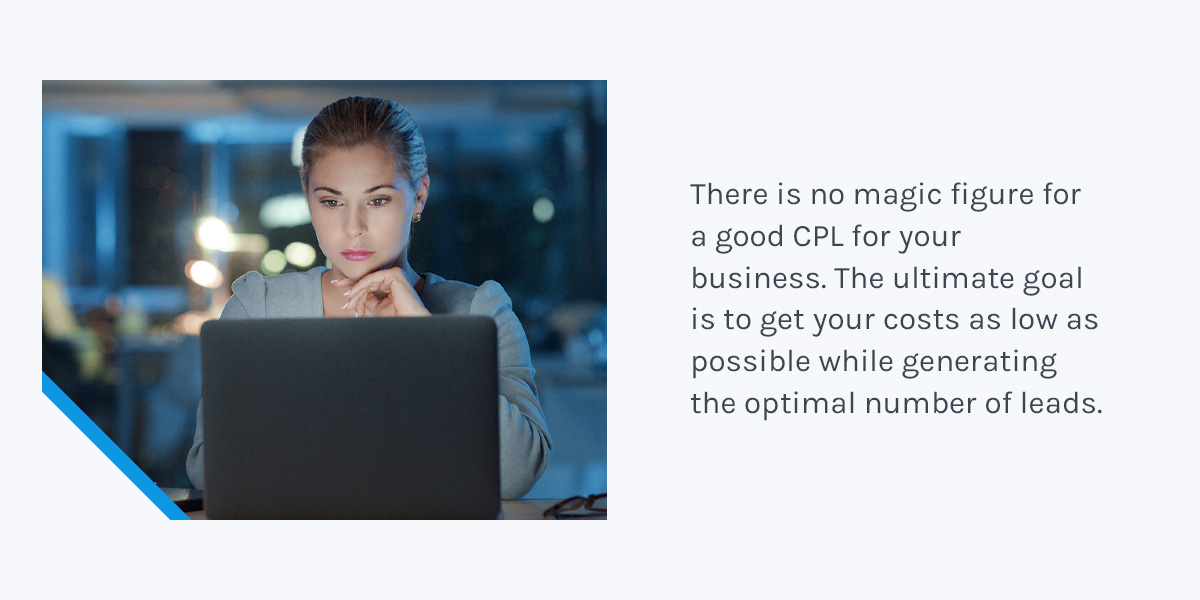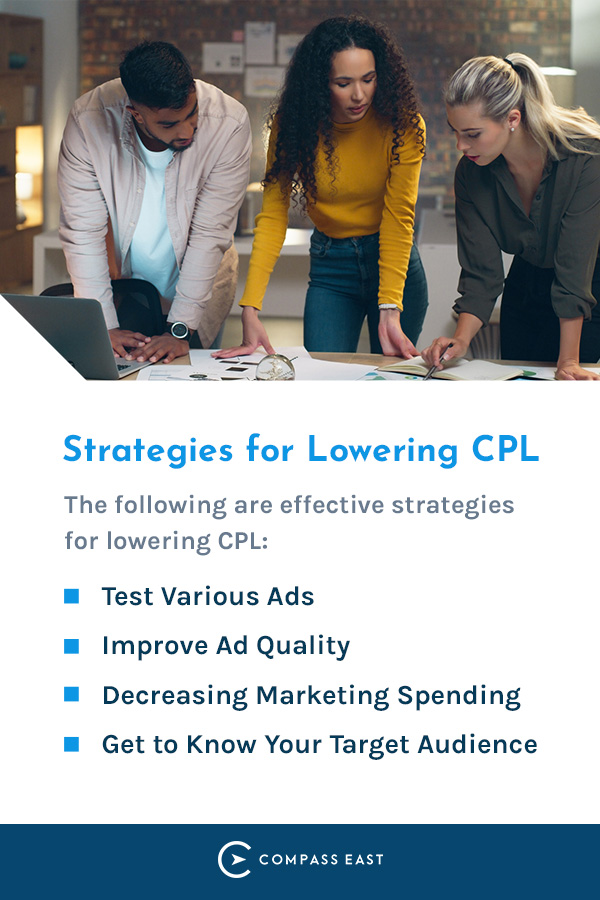Businesses looking to grow and increase profits must understand, identify and track key performance indicators (KPIs), such as customer acquisition cost (CAC) and cost per lead (CPL). These valuable metrics will help your team monitor the effectiveness of your marketing campaigns and inform important decision-making for the future.
We are breaking down CAC and CPL to help you understand the importance of each in refining your business practices and supercharging your growth.
Customer Acquisition Cost Explained
Customer acquisition cost is the measure of how much a business spends on sales and marketing efforts to acquire a new customer. CAC is a valuable KPI that businesses should track and analyze to optimize their campaigns’ success.
Businesses have to strike a delicate balance when spending money on customer acquisition. If they spend too little, they could lose out on potential revenue and growth. If they spend too much, they could lose money and be unable to turn a profit.
The primary goal for a company working on acquisition costs is to spend the lowest amount of money to get the maximum number of new customers. A low CAC will help you maximize business growth and minimize overall spending.
Customer acquisition cost is closely related to customer lifetime value (LTV). Both are useful metrics that provide important context for the other. LTV refers to the average amount that a customer spends at your business before they are no longer a paying customer.
For example, the average paying subscriber might spend about $2,000 before they cancel their account. When you compare this LTV value to your company’s CAC, you can better understand what you’re spending on marketing and sales versus the profits you are getting in return. If the LTV is $2,000 and the CAC is $900, then your business is turning a good profit. However, if your LTV is $2,000 and your CAC is $2,200, then you are losing money and need to reevaluate your spending strategy.
Calculating CAC
Determining your business’s CAC is pretty straightforward. To calculate your customer acquisition cost, you’ll take the amount of money that your company spent on sales and marketing efforts over a particular period. Divide that number by the number of customers you’ve acquired during that same time frame.
When narrowing down which sales and marketing expenses to consider in your CAC calculation, your company should include all costs associated with these efforts. These expenses might include the following:
- Design costs for marketing and sales materials
- Sales and marketing team salaries
- Cost of digital tools and services used to create or share these materials
An example would be if your business spent $10,000 developing and rolling out sales and marketing materials over six months. You would find out how many new customers your company acquired over those months. Let’s say you acquired 200 customers. You’d divide the $10,000 spent by the 200 customers to get a CAC of $50.
Your business’s ideal customer acquisition cost will depend on a few factors, such as your specific industry and target market. Instead of measuring your business’s success based on other companies and benchmarks, you’ll want to compare it to your LVT and ensure you are making more money than you are spending.

Why Is CAC Important?
There are many different reasons your business should track its customer acquisition costs. This valuable metric indicates the overall effectiveness of your strategy to get more paying customers, directly impacting your ability to expand.
The following are some of the key reasons why tracking CAC is important for companies:
- Increasing your profit margins: By taking the time to determine and analyze your CAC, your business can make data-backed decisions that reduce how much you’re spending to convert customers and boost your overall profit margins.
- Determining favorable channels: Your CAC also indicates which channels benefit your business most in attracting paying customers. By eliminating the channels that are not successfully luring in new consumers, you can optimize your ROI.
- Optimizing your marketing and sales efforts: In addition to choosing the right channels for reaching your target market, CAC also helps businesses determine if there is an issue with or opportunity for optimization with marketing and sales spending.
- Demonstrating scalability to potential investors: You can use your CAC to demonstrate the scalability and potential expansion of your business to potential investors.
Overall, your business’s customer acquisition cost determines the growth and profitability of your company.
Strategies for Lowering CAC
Explore some of the key strategies for reducing customer acquisition costs:
Maximize Conversions
One effective method for lowering CAC is to focus on boosting your company’s conversion rates. Different strategies, such as A/B testing, can help you maximize prospect-to-customer conversions without needing to attract additional traffic to your website or business.
Experimenting with different designs and elements will help you convert more people into paying customers while lowering new customer acquisition costs. The bottom line is higher conversion rates mean lower CAC.
Analyze Your Sales Funnel
Revamping your sales funnel is another strategy for minimizing customer acquisition costs. Analyze your entire customer journey to identify areas where potential buyers drop off and could use improvement.
For example, a business may notice a lot of shoppers are not making it past their product’s free trial. They may need to make improvements at this stage in the sales funnel by rethinking the marketing or eradicating a key pain point.
With an understanding of which strategies yield the highest and lowest CAC, your business can optimize its sales funnel, save costs and boost profits.
Automate Lead Generation
Introducing automation into your lead generation efforts can be highly beneficial for high-growth businesses looking to lower customer acquisition costs.
Marketing software has automated tools and capabilities to increase efficiency and reduce employee workloads. Automation saves your business time, money and energy while generating more leads at a lower overall cost. Other tactics like retargeting use automation to improve conversions and lower CAC.
Prioritize Innovation
Finding innovative ways to connect with more customers is essential for businesses looking to lower customer acquisition costs. Doing things like testing new marketing channels and measuring the CAC for each can help your company establish the most cost-effective strategies.
Cost Per Lead Explained
Cost per lead refers to the amount of money a company spends to acquire a new lead within a specific time frame. Businesses sometimes confuse CPL with customer acquisition costs, but the two measure different things.
Time is an essential factor when exploring your company’s cost per lead. You can measure a campaign, channel or market’s CPL according to the following time frames:
- Days
- Months
- Quarters
- Years
- Custom periods
Ideally, A business would have an average cost per lead across all its unique marketing channels. With that said, it is highly beneficial to explore the CPL for each individual channel, including:
- Social Media
- Paid ads
Once you understand which channels have the lower CPL, your company can start optimizing campaigns to minimize spending while maximizing your leads.
Businesses will benefit the most from exploiting the marketing channels that have the lowest CPL and the highest acquired leads. This metric helps you see what channels are worth investing more time and money into because they generate leads that become paying customers.

Calculating CPL
To find your business’s cost per lead for a campaign or channel, you need to determine how much you’ve spent on your sales and marketing materials over a particular period. Then identify the number of leads that your company acquired during that specific time for a particular channel. You will divide your total expenses by the leads you’ve accumulated.
Say your business spent $2,500 on paid advertisements for Instagram over a six-month period. During that time, you generated 500 leads from the platform. You would divide how much you spent by the number of leads you acquired. In this case, your business’s CPL would be $5.
If your business spent $2,500 and only harnessed five leads over six months, the CPL would be $500, and you would likely want to reevaluate your approach to lead generation.
There is no magic figure for a good CPL for your business. Instead, your optimal CPL will rely on factors like your industry, competition and market size. The ultimate goal is to get your costs as low as possible while generating the optimal number of leads.
To determine a good baseline for this metric, take a closer look at the following:
- Campaign history
- Customer lifetime value
- Lead to customer conversion rates
- Return on investment
Why Is CPL Important?
Cost per lead is an important metric businesses should track because it offers valuable insights into lead generation strategies.
Your company can use your CPL to determine the average amount you spend for a new lead according to each specific channel. For example, you can narrow down the cost of lead generation solely for your social media advertising or email campaigns. This will help you understand what mediums are and are not currently working for your operations.
Tracking your CPL will help your business identify the channels that generate the most promising leads that are likely to convert into paying customers. You can then focus your attention and resources on the channels that deliver the most qualified leads that will eventually grow your business’s profits.
You can also use cost per lead to calculate the ROI of your specific marketing campaigns or channels. With an understanding of these metrics, businesses can create effective marketing strategies that optimize their growth while minimizing costs. When you track both, your company can identify if its investments are turning a profit or if they need to pivot its strategy.
Cost per lead lets you see the effectiveness of your marketing materials in attracting new leads that are highly likely to turn into loyal, paying customers already interested in the products or services you offer.

Strategies for Lowering CPL
Acquiring leads is key to converting them into paying customers and boosting your business’s revenue. The following are effective strategies for lowering CPL:
Test Various Ads
Among the best ways to lower your business’s cost per lead is to try different advertisements and campaigns to identify what connects with your target market most effectively. A/B testing is one way to evaluate your ads. Analyzing their performance can help you decipher which design elements, copy and formatting work best for generating new leads.
Improve Ad Quality
While it may sound simple, improving your ad quality is a powerful method for lowering CPL. Your campaigns should be thoughtful and continuously refined to become better.
Compare your business’s campaigns and their performance. Consider the elements that resonate with your target market best and analyze your metrics to see how well they worked in attracting new customers. Better ad quality often means lower costs per lead.
Reduce Marketing Spend
If your business is looking to lower its CPL, consider cutting back on your marketing budget. The trick here is to maintain the same or more leads with less spending. Review your marketing methods and identify ways to supercharge those efforts without paying more money.
For example, your company could prioritize organic growth with search engine optimization or research high-traffic keywords that will increase brand exposure while lowering CPL.
Get to Know Your Target Audience
Another strategy for lowering cost per lead is understanding your target audience better. The more information you have about your specific market, the more you can tailor your marketing efforts to them.
Their location, values, interests and pain points will help you craft more meaningful messages that resonate with the right people and generate promising, quality leads. Diving into your customer data and using it to craft campaigns based on your unique target audience can effectively lower your CPL.
Key Differences Between CAC and CPL
CAC and CPL are very important metrics to monitor for high-growth businesses. Understanding the key differences between the two will benefit your mission and help you transform your marketing and advertising efforts.
Overall, the main difference between these metrics is that cost per lead refers to how much it costs your business to acquire a new lead, while customer acquisition cost is the amount you spend to acquire a new customer.
Your company will want to optimize lead-to-customer conversions, but you cannot do so without understanding the costs associated with lead generation and acquiring new paying customers. Working with experts can help you monitor and improve these key performance indicators.

How Compass East Can Support Your Business
Compass East supports businesses in tracking CAC, CPL, and other important KPIs. That process starts with acquiring high-quality data.
We work closely with you to ensure your data is accurate and comprehensive. This approach involves assessing not only your financial data but also non-financial (operational) metrics and reporting from across your organization.
With clean, comprehensive data in place, we can calculate and analyze CAC and CPL effectively to help you understand the true cost of acquiring customers and generating leads.
Using CAC and CPL Metrics for Financial Reporting and Forecasting
The right metrics can provide valuable insights into your marketing strategy. For instance, knowing your CAC and LTV allows you to assess whether increasing your marketing budget will yield positive results. Without accurate data, these decisions are speculative at best.
If your organization’s marketing department has its own KPIs, our team can help determine which KPIs are most important to roll up to the senior leadership team for financial reporting and forecasting. Typically, CAC and LTV metrics remain at the departmental level until there’s a question about spending that needs a deeper dive.
Benchmarking CAC and CPL Metrics to Help Identify Issues
Understanding whether your CAC and CPL numbers are too high or low is essential. We can help you benchmark these metrics against company-specific historical data and industry standards, although keep in mind that industry benchmarks might not always be relevant due to differences in size and scale.
Our approach involves scrutinizing data validity and collaborating with your department leaders to identify and address any discrepancies. From there, you’ll have the insights you need to make informed decisions that drive your company’s growth.
Contact Compass East to Learn More About KPI Development
If your business could use some help reaching your financial potential, turn to the team of experts at Compass East. We have all the finance and accounting solutions needed to help growing companies achieve efficient and sustainable business models.
Our advisors can assist you with cloud-based solutions and analytical expertise. We’ll create the technological environment you need for effective financial KPI development. By tracking important insights about your operations, your business can improve decision-making and scalability.
Explore Compass East’s KPI dashboard and development solutions from Compass East, or reach out to us to get started today.
